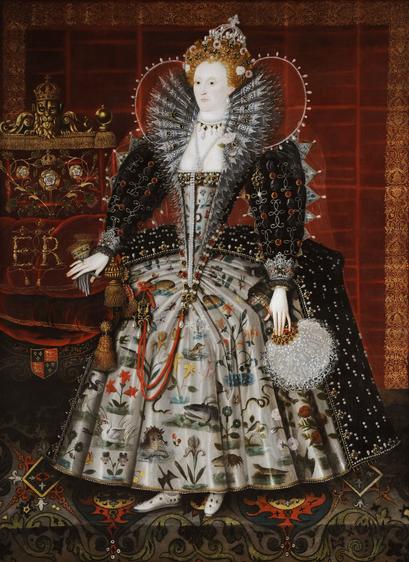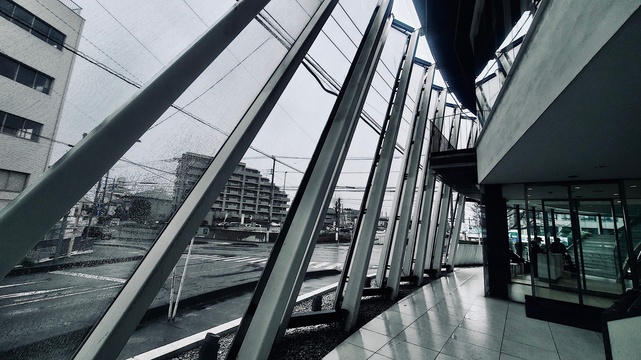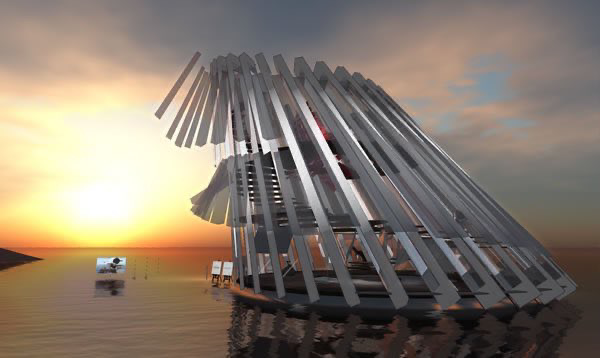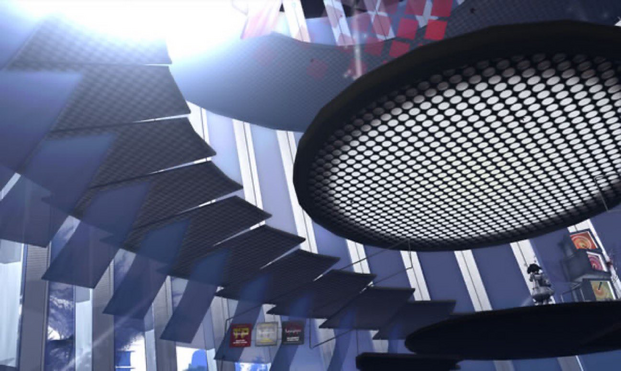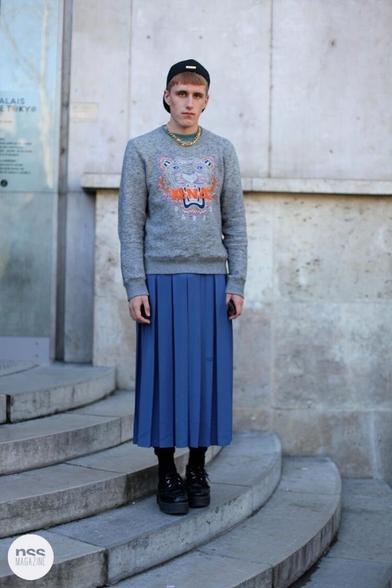Is it just me, or does this outfit make Elizabeth I look like she should have a few more sets of feet poking out under that hem? Feet which are attached to disproportionately short legs...
#history #fashion #proportion #dressmaking #pleats #art
#pleats
#入間サーカス 開催中の式場 #Pleats.I ( #プリーツドットアイ )を見て来た。カメラマン&モデル以外内部撮影は出来ないそうなので外から一枚📷
……📷の角度だと私が昔 #仮想空間 ( #SecondLife )に建てた建造物 ”水と光が流れるアートミュージアム➕コンサートホール” を思い出し懐かしい気持ちに☺️
A ‘time crystal’ is in many ways like a crystal in space: the crystals with which we are all familiar. … Whereas the crystals & crystallizations with which we are all familiar—for instance the ice-crystals that form in our refrigerator-freezers or on the surface of our windows in winter—can be seen in their entirety all-at-once, the crystallizations definitive of ‘time-crystals’ aren’t able to be witnessed from one spatio-temporal vantage-point: the crystal pattern (the repeated pattern that makes them ‘crystals’) occurs at different points in time, such that at any ᴏɴᴇ point in time the repeated pattern can only be partially or fragmentarily observed. In a sense, “the future” is built into the structure of time-crystals (just in case you were wondering why I mention them at all). I’m an expert in none of this, and—like many non-experts—when I glance online for definitions of time-crystals, I find one ready-&-raring to go on good-old Wikipedia: “Ordinary (non-time) crystals form through spontaneous symmetry-breaking related to a spatial symmetry. Such processes can produce materials with interesting properties, such as diamonds, salt-crystals, and ferromagnetic metals. By analogy, a ‘time crystal’ arises through the spontaneous breaking of a time symmetry” … Hmmm: Ok, but not really that helpful. Perhaps a bit more helpful (with regard to getting a sense of ‘time crystals’) is a section (in time) of the late Carl Sagan’s old 13-part mini-series recorded 43 years ago (in 1980) for PBS: the Public Broadcasting Service in the U·S of A—specifically the section in episode ten of that series (a series called #Cosmos), the episode entitled ‘On the Edge of Forever’, wherein Sagan describes four-dimensional objects (and, as a matter of fact—or sci-fi,—four-dimensional ‘subjects’). Since you’ve all seen this Seven-minute Slice of Saganism, I can proceed with the confidence that it’s still playing in your mind’s eye or Nietzschean theatre-eye—(“the great ‘third eye’ that looks out into the world through the other two). … From our three-dimensional perspective, the incursion (and the witnessing) of four-dimensional subjects-or-objects appears like that fragmented cross-section of the 3D apple dropped into the 2D flatland: something that comes-across as a glitch in our vision, a strange short-lived hallucination, oddly-shaped, partial, and literally out-of-this-world. … Of course, that’s not the case (that wouldn’t be the case) for the 4D object-&/or-subject: from the perspective of the 4D object-or-subject, its ‘being’ is there in its entirety.
Here we can reference the Canadian film-director Denis Villeneuve’s 2016 film #Arrival, which dealt with the arrival (in our human-all-too-human 3D-world) of creatures that move, think and communicate in four dimensions. The protagonist, Louise Banks, starts ‘remembering’ shards of a past she never lived—glimpses of things that haven’t happened—and slowly realizes that these fragmentary memories are actually memories of the future and that (for all of its blind-spots/gaps/holes) her life forms a Whole-with-a-W which, from a 3D perspective, ᴄᴀɴ’ᴛ be perceived—but from a 4D perspective ᴄᴀɴ be. … The 4D-creatures communicate in the language of “Whole-with-a-W”·life ᴛɪᴍᴇ-ʟᴏᴏᴘꜱ with a circular logic that transcends any single/singular time-&-place. Their script, from Louise Banks’ (and her fellow-humans’) perspective, is a series of loops, circles or cycles: curved-or-bent lines that fold-in on themselves. … In Villeneuve’s newest film-qua-set-of-films (#Dune), this logic & language is one that “folds space”-&-spacetime, allowing its users to travel vast (and in our case impossible) distances without actually moving—since in four dimensions they (the users) are always already there (as long as they have-been-there, as long as they have a ‘there-being’ or Da-sein). Sagan, in the video-clip, also noted that if a 2-dimensional creature from the flatland were carried upward (beyond its own dimensions) into the 3rd dimension, the flatlander would suddenly be able to see through 2-dimensional walls—and something similar would of course be the case if a3-dimensional creature such as Louise Banks (in #Arrival) or Paul Atreides (in #Dune) were to be lifted out of their own 3-dimensions forth into the fourth dimension: in this case, they would be able to see through 3-dimensional walls—3-dimensional obstacles—and witness a world where (just as, in the 3rd dimension, 2-dimensional objects seem to be the shadows—or 2-dimensional projections—of 3-dimensional objects) 3-dimensional objects seem to be the shadows—or 3-dimensional projections—of 4-dimensional objects. But a 3-dimensional shadow is akin to a sculpture or architectural construct, and as a creature in this fourth dimension moves-about, these 3-dimensional sculptures or architectural constructs ʟɪᴋᴇᴡɪꜱᴇ move-about, shifting and rotating, fracturing and fragmenting (the action of 4D tesseracts, or tesseractions) … To lift a phrase from Christopher Nolan’s film #Tenet, “We live in a twilight world”: a world of shadows (in our case, the 3-dimensional shadows of a 4-dimensional spacetime) … Our perceptions and descriptions and notations—that-is-to-say ʟɪɴɢᴜɪꜱᴛɪᴄ ꜰᴏʀᴍᴜʟᴀᴛɪᴏɴꜱ—of the world are in this respect a ‘ᴛᴡɪʟɪɢʜᴛ ʟᴀɴɢᴜᴀɢᴇ’, and the strange slippage we often find in our words, in our expressions, are evidence not-only of what we call ‘word-play’ (be this intentional or, as is the case much-more-often, unintentional) but also of a kind of ‘shadow-play’: the play of shadows, both in the sense of light-hearted (perhaps sometimes shadow-hearted) playfulness and in the sense of a whole ᴛʜᴇᴀᴛʀᴇ or spectral—nevermind conceptual—ꜱᴘᴇᴄᴛᴀᴄʟᴇ (a very old notion, first made famous, perhaps, by Aristotle’s former teacher Aristocles, better-known by the nickname Plato, in the 7th book of Plato’s #Republic, where the latter suggests—in Wachowski-ᴍᴀᴛʀɪx-like fashion—that we live in the world like people dwelling in a cave perceiving the shadows-on-the-walls as if they were the be-all and end-all of existence-as-such).
Just as ‘folds’ in our 3-dimensional world are difficult to perceive in their 2-dimensional shadow-form, so are ‘folds’ in the 4-dimensional world difficult to perceive in their 3-dimensional shadow-form—and the latter (‘folds’ in 4 dimensions) are folds that not-only fold space but also fold time (in sum, they fold ‘spacetime’). Being stuck in the confines (or ‘cave’) of our 3 dimensions, we are (like the people in Plato’s cave-allegory) ‘shackled’-in-place and ‘tethered’ to one straight timeline (which we call, because of this, “the arrow of time”). If we were able to ‘fold’ time, our ‘past’ and our ‘future’ could overlap, adding a new dimension to our worldly 3-dimensions and permitting us a re-visiting &/or pre-visiting of various parts of our lives, as-well-as (as I mentioned before) problematizing everything I have previously said about our relation to the ‘past’, ‘present’, and ‘future’ (our ‘relation’ to these and also our non-relation to them—especially with respect to ‘the future’). … The heptapods in Villeneuve’s #Arrival ʟɪᴠᴇ, ʙʀᴇᴀᴛʜᴇ, and ᴍᴏᴠᴇ in a world with respect to which ours is a shadow (or play-of-shadows); their squid-ink writing takes the form of full-loops because they reference (and exist in) time-loops (loops in time) … and they are fluid rather than fixed-in-place/fixed-in-time for the same reason. The fluidity here (in German, ein Fluss) brings me back to the theorist Vilém Flusser (whose surname surreally evokes such a flux) and his treatise on the barely-known very-deep-sea infernalis squid, which was Flusser’s clever ‘cover’—‘cover-story’—for writing a text about dealing with the unknown or barely-known. When I gave a talk (in May of 2015) at a conference on Flusser and Marshall McLuhan, I started my presentation with reference to Samuel Beckett, Sarah Kofman and Marcel Détienne, all of whom were concerned with what the ancient Greeks called ‘aporia’: ‘impasses’ in thinking and knowing. Beckett began his book #The_Unnamable (about guess-what?—ʏᴇꜱ: something ᴜɴɴᴀᴍᴀʙʟᴇ) with a question about how he could proceed—how he could write—about something unnamable, something beyond his capacity to name. … “How to proceed?—by aporia pure-&-simple? or by affirmations-&-negations invalidated-as-uttered (or sooner-or-later)?” #The_Unnamable—from its first page to its last—is all about this aporia. Sarah Kofman (one of Jacques Derrida’s former students) argues that any-&-every aporia is just an enigma—noting that an oft-used synonym for enigma amongst ancient Greek writers was the word griphos (both words meaning a #conundrum, a #difficult_passage or #riddle), and that griphos is a kind of fishing-net, a woven fabric in the #pleats, #folds, or #knots of which we tend to get trapped (we 3-dimensional creatures). Kofman used (as one of her source-books) a famous study by Marcel Détienne and Jean-Pierre Vernant which suggested that the arms of the squid &/or octopus (‘arms’ in all senses of the word) functioned—for the Greeks—like griphoi, like nets, and that the squid &/or octopus was not only a master trapper but also an expert escaper: a creature that can cast-&-escape from such griphoi/aporia.
In Villeneuve’s #Arrival, the squid-or-octopus-like heptapod that is given the name Abbott (and hence isn’t unnamable for Ian or for Louise) dies precisely because it chooses not to escape the rebel soldiers’s detonation. It could have escaped it, but chose not to (in order to save Louise and Ian), as the other heptapod, given the name Costello, explains to Louise via its fluid loop-writing … “Abbott is dead” states Costello, with an explanation for this death that is tellingly also written in the present tense: “Abbott chooses to save Louise and Ian.” Abbott is dead and Abbott chooses to save Louise and Ian: these are two statements on a looped continuum. When Louise then asks Costello to explain the purpose of their visit (the purpose of their arrival), Costello’s script gestures toward the future (still, of course, in the present tense) as the source of their present objectives: “3,000 years from this point, humanity helps us. We help humanity now—returning the favor.” Returning a favor that takes place in the future: four-dimensional logic.
[[#ᴄᴏɴᴛɪɴᴜᴇᴅ]]
apparently #pleats are back in men's fashion.
deep down i always knew my pair of z cavariccis from high school would pay off someday.
